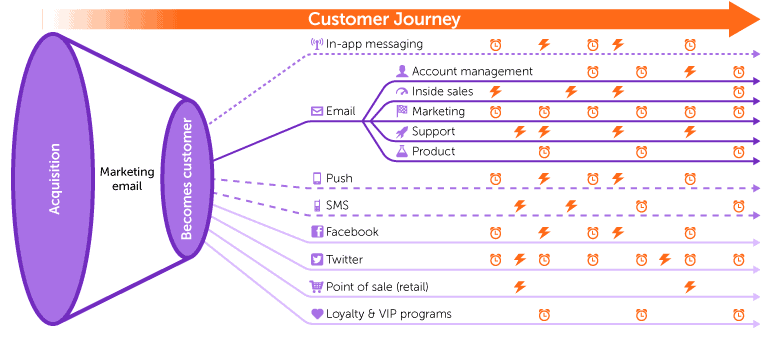Marketing Automation is very effective way to reduce human error, increase efficiency, remove expense and drive sales.
It can also be a great way to waste time and money in overly complex and ineffective processes.
After using at least six completely different marketing automation platforms over a 20 year period, I have the battle scars to know what works and what doesn’t.
In this post I’ll show you marketing automation best practices applicable to all technology platforms that create systems which are effective and can be managed long term.
- 1 Start with your Customer Journey Map
- 2. Think Big: Automate Processes not just Campaigns
- 2. Create An Overall Strategy
- 4. Start Simple and Build Over Time
- 5. Test, Test, Test
- 6. Use as Few Systems as Possible, Even if you Have to Compromise Functionality
- 7. Document as Much As You Can
- 8. Create Naming Conventions
- 9. Don't Automate Complex Rules / Special Cases / Small Volumes
1 Start with your Customer Journey Map
Customer Journey Maps document the customer’s path from Awareness to Prospect to Customer. Their focus is to document the customer’s journey through the entire marketing process and sales process.
With so many automation options, communication channels (email, SMS, facebook, etc.), sales funnel stages, etc. journey maps are critical in communicating what needs to happen for each customer segment and stage of the customer journey.

2. Think Big: Automate Processes not just Campaigns
Automating lead nurture email campaigns is an obvious opportunity but you should think big.
How can you automate entire sections of your sales and marketing process?
What about:
- Automating the customer onboarding sequence with integrated video training that reacts to what they have viewed/not viewed.
- Automating the sales forecasting process by pre-warning account managers to update their forecasts and alerting sales managers to deals that have not be updated for 30 days.
- Automating the entire quarterly business review process including pre-alerting customers to book a time, sending surveys and collating reports.
2. Create An Overall Strategy
This may be a surprise but none of these systems is difficult to configure.
Sure their are individual complexities to master for each vendor but the developers have spent countless hours creating user interfaces that are easy and, moderately, intuitive to use.
The actual hard part is deciding what you want it to do:
- What workflows do you need to automate?
- Which area will drive the most value?
- What is the actual copy in the email?
- Which pageviews are most important?
- What is the right email cadence?
- etc.
So start there first.
Honestly, don’t dive into creating workflows and alerts.
Start with a whiteboard or pencil and paper to plan out what you want to do at a high level then work down to the detail.
4. Start Simple and Build Over Time
It’s much easier to build your automation implementation progressively over time than design a 50 step process and launch it in one big bang.
Software developers learned this a long time ago.
Instead, build stage by stage. Test what works and what doesn’t, adapt, fine tune and improve as you go.
You’ll get quick wins on the board to demonstrate success to management AND stable long term success.

5. Test, Test, Test
You’ve heard of Always Be Closing; well this is Always Be Testing.
There are two sorts of testing you need to do:
1. Test If The automation Does What You Think It Does
Software developers call this bug testing – yes, you’re a software developer now! Congratulations.
You must test to ensure there are no unintended consequences of your automation and that it does what you think it will do.
Sometimes small changes in an automation set up can have major impacts on what the automation actually does. So test in as many different ways as you can think of.
Remember, if poor testing causes the list of your most valuable customers to be applied to the debt recovery marketing automation sequence, no one will be smiling.
2. Test the Performance of the Automation
This is more familiar to marketing folk. It’s the sort of A/B testing you’ve been running for years.
Time and again review the performance of nurture series, emails (clicks, opens), Calls to Actions (clicks and conversions), structures, etc.
Often you can dramatically improve performance of your automation, not by starting from scratch, but by tweaking small elements.
If your marketing automation supplier provides the ability to run formal A/B tests, use it.
6. Use as Few Systems as Possible, Even if you Have to Compromise Functionality
With the apparent ease of integration that platforms like Zapier and ITTT provide you might think you can string together a bunch of best in class systems and be successful.
Maybe, but probably not.
It is true, it’s easier than ever to push data from one SaaS platform to another. However, each integration makes the whole system more fragile, complex and difficult to maintain.
Try, as much as possible, to keep everything in one system.
Often it’s better to deliver a slightly less than perfect automation using the system you have, than graft on an additional piece of software.
7. Document as Much As You Can
The software vendors all imply that these systems are self documenting, i.e. there is no need to document externally.
Trust me, they are not.
Looking back at an automation you created just a month ago can seem like reviewing the scribblings of a mad person.
Why did I do it that way – it makes no sense!
If you’re looking at someone else’s automation it’s worse.
So document as much of the process in high level diagrams (PowerPoint, Google Presentation, etc) as you can. It will make it much easier long term.
8. Create Naming Conventions
It seems like a small thing but document your naming conventions somewhere and stick to it.
Again, software developers learned this a long time ago. If you name things in a consistent way it makes it much easier to understand later.
Here are some ideas of what works when naming workflows, elements, properties, etc:
- When naming a thing, start from the big picture and work down to do the detail, e.g. “Div A Campaign B Sales Lead Allocation Workflow”
- Choose words with meaning that create context
- Avoid generic names (like
test, check, new, temp, old) - Don’t make your names too long or too short: they should be just long enough to describe what they do
- Use consistent formatting (Case) and, most importantly, abbreviations, e.g. don’t find yourself with different versions of the same idea like this: Division, Div, Dn, div, division….
You’ll be surprised how often you’ll appreciate this small idea.

9. Don’t Automate Complex Rules / Special Cases / Small Volumes
Deciding what not to automate is almost as important as deciding what to automate.
Marketing automation is an 80/20 game, like most of life. You’ll get most value from automating high volume, simple, consistent processes.
So:
- If something only happens occasionally; don’t automate it.
- If you can’t write down or draw a simple description of what the automation will do; don’t automate it.
- If you need to handle lots of uncommon exceptions; don’t automate it.
A good example of the first point is automated lead scoring in SME B2B organisations.
Sure, if you’re a large organisation and generating 50 leads a day you need automated lead scoring.
But if you’re a SME B2B generating one lead a day. It will take forever to generate enough history to validate your automation.
It’s not as cool to do it manually but it will be more effective and probably take less time overall.






